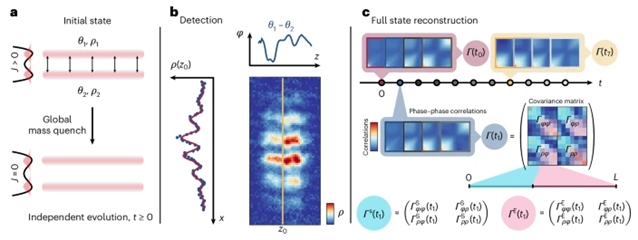
美国加州理工学院Mohammadamin Tajik团队报道了量子多体体系中实验探索Landauer原理。相关论文于2025年6月5日发表在《自然—物理学》杂志上。
Landauer原理通过将过程中系统的熵变与其环境中耗散的平均能量联系起来,将信息论和热力学联系起来。尽管通常在擦除单个信息位的背景下进行讨论,但Landauer原理可以推广到表征非平衡过程中的不可逆性,例如涉及复杂量子多体系统的过程。具体来说,系统的熵变与其环境耗散的能量之间的关系可以分解为量子互信息的变化和环境相对熵的差异。
研究组使用超冷玻色气体的量子场模拟器在量子多体体系中实验性地探索了Landauer原理。采用动态断层重建方案,他们跟踪了量子场在从大质量到无质量克莱因-戈登模型的全局质量猝灭后的时间演化,并分析了热力学和信息论对复合系统各种系统-环境分区的广义熵产生的贡献。该结果验证了使用半经典准粒子图像解释的量子场理论计算。该工作证明了基于超冷原子的量子场模拟器在实验研究量子热力学方面的能力。
附:英文原文
Title: Experimentally probing Landauer’s principle in the quantum many-body regime
Author: Aimet, Stefan, Tajik, Mohammadamin, Tournaire, Gabrielle, Schttelkopf, Philipp, Sabino, Joo, Sotiriadis, Spyros, Guarnieri, Giacomo, Schmiedmayer, Jrg, Eisert, Jens
Issue&Volume: 2025-06-05
Abstract: Landauer’s principle bridges information theory and thermodynamics by linking the entropy change of a system during a process to the average energy dissipated to its environment. Although typically discussed in the context of erasing a single bit of information, Landauer’s principle can be generalized to characterize irreversibility in out-of-equilibrium processes, such as those involving complex quantum many-body systems. Specifically, the relation between the entropy change of a system and the energy dissipated to its environment can be decomposed into changes in quantum mutual information and a difference in the relative entropies of the environment. Here, we experimentally probe Landauer’s principle in the quantum many-body regime using a quantum field simulator of ultracold Bose gases. Employing a dynamical tomographic reconstruction scheme, we track the temporal evolution of the quantum field following a global mass quench from a massive to a massless Klein–Gordon model and analyse the thermodynamic and information-theoretic contributions to a generalized entropy production for various system–environment partitions of the composite system. Our results verify the quantum field theoretical calculations, interpreted using a semi-classical quasiparticle picture. Our work demonstrates the ability of ultracold atom-based quantum field simulators to experimentally investigate quantum thermodynamics.
DOI: 10.1038/s41567-025-02930-9
Source: https://www.nature.com/articles/s41567-025-02930-9
